There’s tons of wild moves in Karate.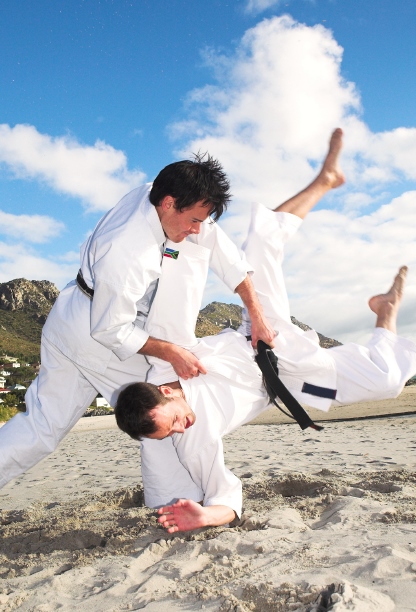
At least if you know where to look.
Having been around the world in pursuit of such techniques for many years now, I’m always amazed when I bump into Karate people who have no clue that there’s all kinds of crazy stuff in old-school Karate.
I’m talking joint locks, throws, ground fighting, strangulations, pressure points, takedowns and other unconventional methods of subduing an aggressive opponent.
But perhaps I shouldn’t be so amazed?
The modern 3K (Kata/Kihon/Kumite) systematization and subsequent sportification of Karate has unevitably led to the decline of many authentic Karate techniques, as their original intent was/is simply too dangerous for the more civilized setting in which Karate is commonly taught today.
I mean, what responsible parent would send her kids to Karate class if they were taught to cripple each other?
I wouldn’t.
Neither would you.
Still, we’re not kids. We’re adults – with fully functioning brains and a highly developed sense of good judgement – meaning we can, and should, strive to dig deeper into the treasure chests of old-style Karate to uncover those precious gems with the potential of making us bona fide Karate Nerds™.
So check this out…
Today I would like to take you along a journey through Karate history, by exploring the writings of the legendary Funakoshi Gichin, as we examine his historical outline of nine lost throwing techniques of traditional Karate (‘nage-waza’).
Obviously, these techniques weren’t really “lost” during sensei Funakoshi’s time. In fact, many of his peers repeatedly demonstrated similar techniques in their writings. It is only quite recently they’ve begun to disappear from dojos around the world, as “punch-kick Karate” is steadily taking the center stage of worldwide Karate attention.
Nevertheless, original Karate was far more than that!
So, with these words, let me to present to you ‘The 9 Lost Throws of Funakoshi Gichin: Karate’s Forgotten Takedown Techniques’.
Here we go:
#1. Byobu Daoshi: ‘Topple a Folding Screen’
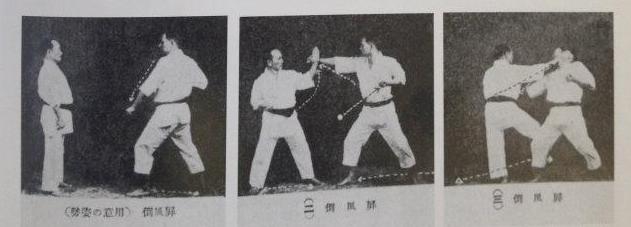
As demonstrated in his groundbreaking work Karatedo Kyohan, the first of these nine throws by Funakoshi sensei is called byobu daoshi.
Byobu literally means a traditional folding screen, commonly used in Japanese society for dividing rooms and private spaces, while daoshi (taoshi) simply means to knock over, or topple, something.
Hence, as shown by Funakoshi sensei above, when the high punch (jodan-zuki) comes towards your face, slide back and block it with your open front hand, and proceed by quickly grabbing the attacking wrist with your blocking hand while forcefully slamming and grabbing the chin/throat of your opponent with your free hand.
At the same time, swiftly step behind your opponent and trip him backwards over your leg (similar to Judo’s osotogari throw).
Sweet, simple & dirty – just like it should be.
#2. Koma Nage: ‘Spinning Top Throw’
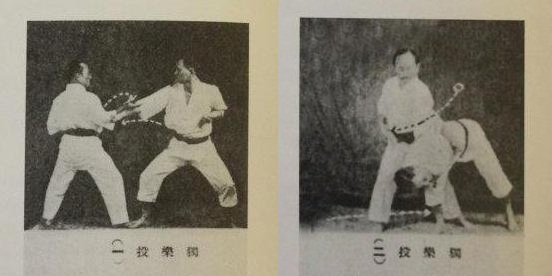
In this next throw, Funakoshi sensei beautifully marries a popular bunkai move from Tekki/Naihanchin kata with the “ju-no-ri” principle so common in Aikido, Ju-jutsu and Judo (and high-level Karate, of course).
As your opponent steps in with a middle punch (chudan-zuki), slide back and block the strike with a dropping block (otoshi-uke) from the outside this time. Immediately grab your opponent’s wrist with your blocking hand, pulling it strongly down to your hip, as you step forward with your leg slightly behind your opponent, placing your free hand on his elbow joint as leverage, effortlessly spinning him around and down to the ground.
The key to really making koma nage work is to utilize the opponent’s incoming force, executing the whole takedown in one smooth motion.
Think “Aikido” flow.
#3. Kubi Wa: ‘Neck Ring’
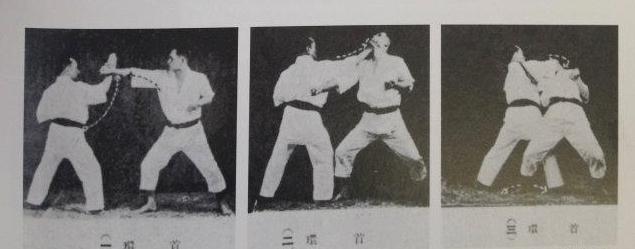
This throw starts out in a fashion similar to both of the previous throws.
As your opponent steps forward with a high punch towards your face (jodan-zuki), slide to the outside and block high with your front hand.
Quickly slide forward (yori-ashi) past the outside of your opponent’s attacking arm, striking him on the chin with your open hand (shotei-uchi). Then, as your opponent flinches, promptly step in behind his front leg (fumi-komi) and circle your outstretched arm behind your opponent’s neck, hugging it tight as your bring him down, simultaneously pushing with your free hand at the small of his back to increase the effectiveness
Interestingly enough, MMA fighters from my academy use a similar technique quite often – with great success!
#4. Katawa Guruma: ‘Cripple Wheel’
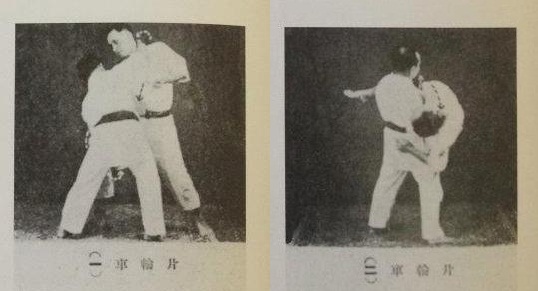
The katawa guruma, or cripple wheel (similar versions are also known as Fireman’s Carry) is a quite popular move in many fighting arts that involve throws (like Judo, Wrestling, Shuao Jiao etc.).
In this case, begin exactly like in thrown #2 (Koma Nage: ‘Spinning Top Throw’), by sliding back to the outside and blocking your opponent’s feeble attempt at crushing your solar-plexus (with a chudan-zuki). Next, move forcefully straight towards your opponent and wedge the attacking arm between the two of you, as you smoothly slide your blocking arm up and grab behind the neck of your opponent (here’s where the above images start to make sense).
Now, with your free hand, reach down between your opponent’s legs and seize his dumplings (or just grab a hold of his thigh), lifting up as high as possible while you pull his neck down to your right backside.
Naturally, you’ll recognize this exact bunkai move from several kata (like Kusanku/Kanku Dai, Passai/Bassai Dai, Unsu/Unshu etc.)
Awesome.
#5. Tsubame Gaeshi: ‘Swallow Reversal’

Funakoshi sensei was known for letting his poetry shine through when naming techniques, and this move is no exception.
To perform the tsubame (lit. swallow, yes, the bird) gaeshi, step back and perform a rising cross block (juji-uke/hasami-uke) with open hands to deflect your opponent’s high punch (jodan-zuki), and immediately grab the attacking arm from the inside, striking to your opponent’s jaw with a vicious backfist (ura-ken) strike.
Then (here’s the tricky part); move towards your punch-drunk opponent in a circular fashion, spinning around while at the same time dropping down to one knee, as you drag your opponent to the ground by twisting his arm around, pulling your hands to your hip.
Just like a drunk swallow landing in its nest.
#6. Yari Dama: ‘Spearing Through’
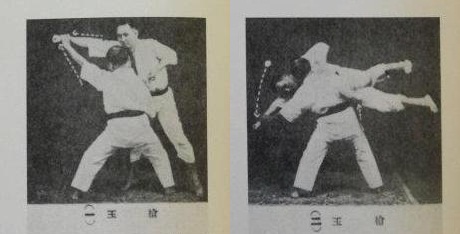
In yet another throw that puts your opponent’s testicular fortitude to the test, your opponent tries to punch you in the mouth again as you slide back and block the punch with your open front hand from the inside (shuto-uke) – just like in the first throw (byobu daoshi).
As always, immediately proceed by grabbing your opponent’s attacking wrist with your blocking hand, and then take a big step foward into a deep sumo stance (“but Jesse-san, that’s weird, we don’t have shiko-dachi in Shotokan!”) and slam your free hand into your opponent’s crown jewels. Laugh at your opponent’s newfound vocal range (note: if he didn’t turn into an opera singer after that last move, he’s probably not a “he”), then slide forward even deeper and finally finish the throw by pulling down to your left side, while lifting up strongly from below.
The main principle is very similar to the katawa guruma (#4).
#7. Tani Otoshi: ‘Valley Drop’
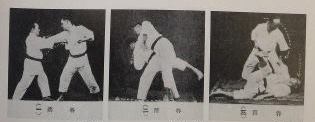
Although tani otoshi is one of the most common moves in competitive Judo nowadays, this throw by Funakoshi sensei more resembles the modern-day version of seoi-nage (albeit with a slightly broader stance) than anything else.
As your opponent lunges forward with a punch to your midsection, step back with your right leg and parry the blow with your front hand, immediately grabbing the attacking arm and pulling it to your side (the real meaning of hikite) while you execute a swift counter strike to your opponent’s soft spot.
As your opponent flinches (if you haven’t figured it out by now; the purpose of these numerous disruptive strikes (atemi-waza) is to take advantage of your opponent’s a natural flinch response, or elicit a pain withdrawal reflex, thereby setting up the subsequent takedown), step forward and swing your attacking arm under your opponent’s outstretched arm, spin around and throw him over your shoulder to the ground.
Finish off by threatening to end his misery, as in the last picture.
#8. Ude Wa: ‘Arm Ring’
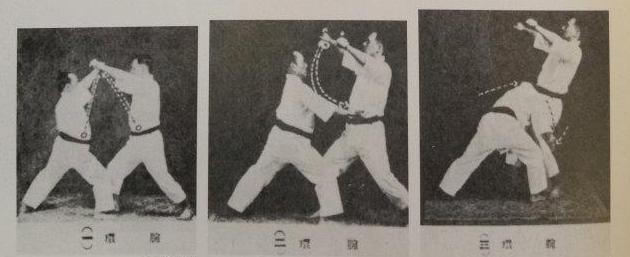
To demonstrate that these throws work when defending from attacks other than straight lunging punches, in this ude wa technique Funakoshi sensei defends against a double handed lapel grab instead.
As your opponent approaches you with both arms outstretched, quickly deflect them upwards and immediately sink into your opponent with double horizontal hammerfist strikes against the midsection (I recommend aiming for the cartilaginous medial portions of the ribs, since they break the easiest). As your opponent gasps for air, lean down and hug his legs tightly while pushing strongly against his hip bone with your shoulder, swinging his legs past yourself and dumping him on the ground.
A perfect example of the four principles of Quan-fa, by the way.
When you try this in the dojo, make sure your partner really knows his breakfalls (ukemi), or else there might be a nasty neck injury on the schedule.
Also, do I even have to mention what kata this bunkai is from?
#9. Gyaku Tsuchi: ‘Reverse Sledgehammer’
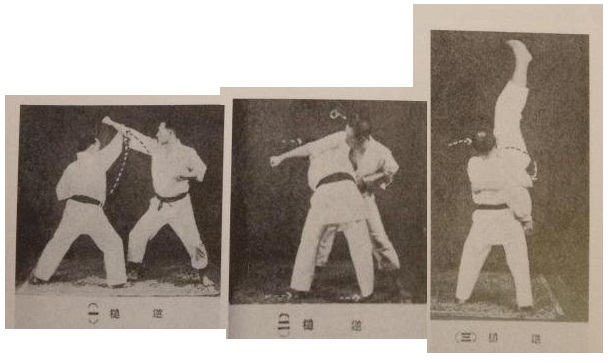
And lastly, my all-time personal favorite old-school Karate throw: the reverse sledgehammer.
Or, as pro wrestlers call it; the piledriver.
As your opponent desperately tries to attack you, deflect his high punch (jodan-zuki) by stepping back with a rising block (age-uke). Quickly slide forward and reach around his upper back with your blocking hand as your free hand slides in front of his belly. Now flip him over, laugh manically for a couple of seconds and finish off by dumping him on his head.
________
And that’s it.
Nine classic, yet pretty wild, Karate throws that you rarely see in the average dojo – straight from the horse’s mouth.
Try them out during your next Karate class!
In the meantime, I want to know what you think of Karate throws in general?
Are they really that useful? Do we even need them? Can they actually be performed by a weaker person (which, after all, is a prerequisite for any effective Karate technique)?
Let me know in the comment section.
Thanks for reading!
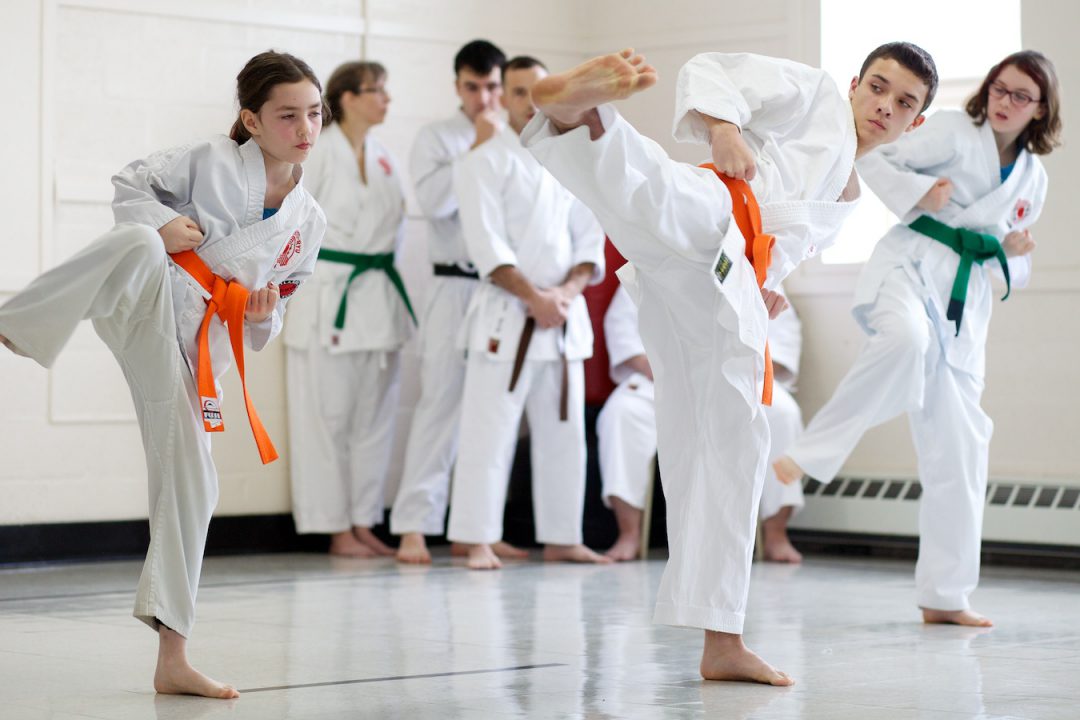
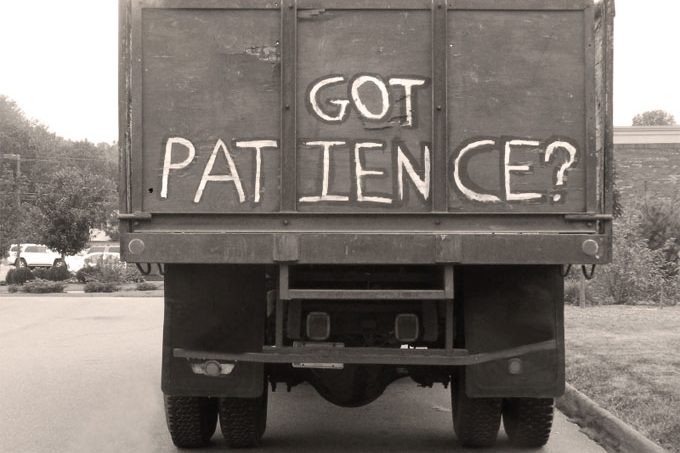

75 Comments